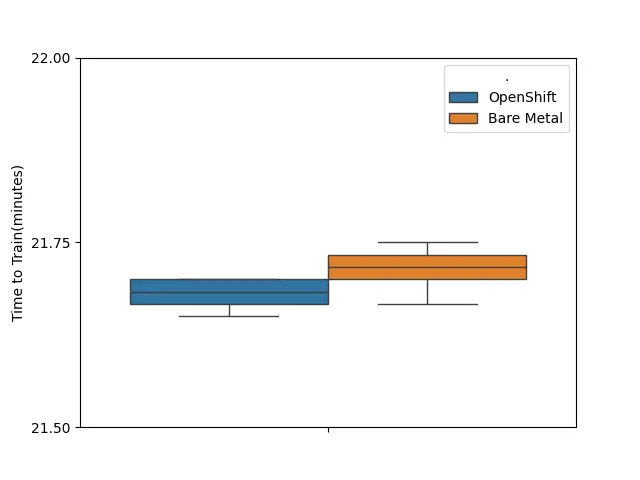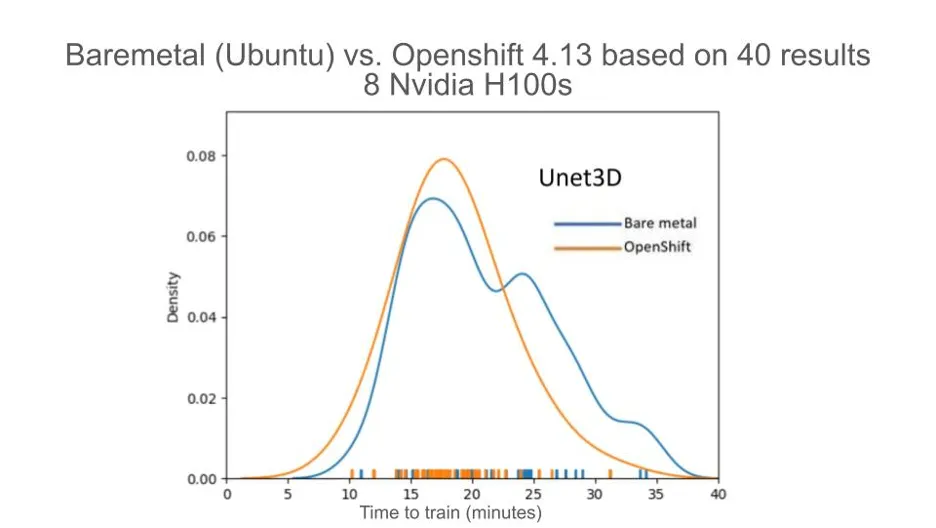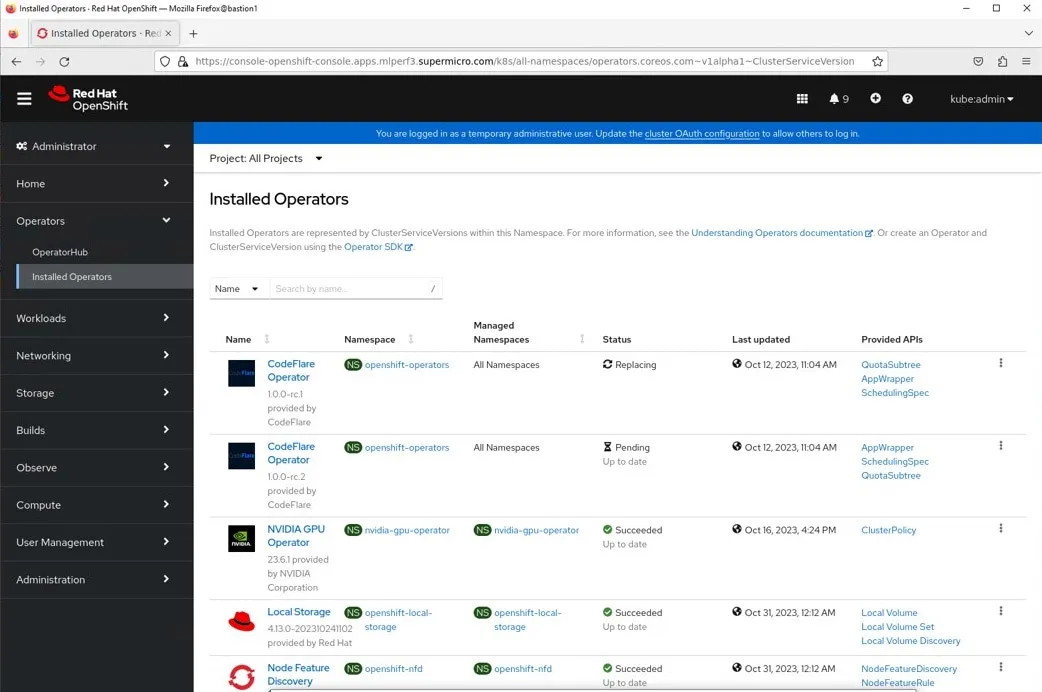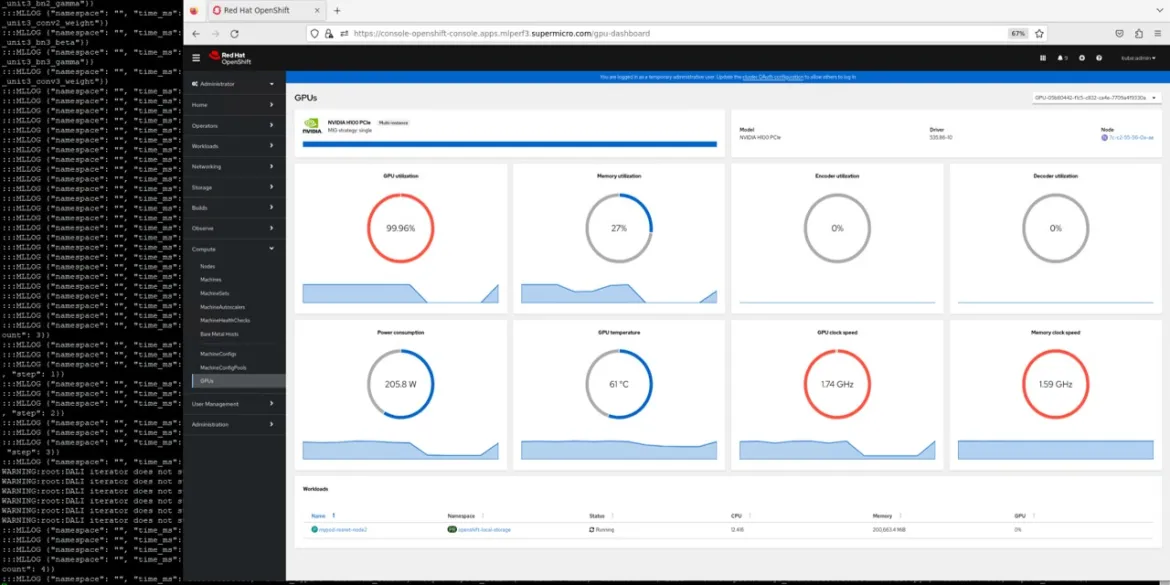We are proud to announce the first MLPerf Training submission on Red Hat OpenShift, which is also the first MLPerf training submission on a variant of Kubernetes. This demonstrates the power of Red Hat OpenShift to solve real world machine learning (ML) problems efficiently while providing all the benefits of enterprise Kubernetes container orchestration. Red Hat collaborated with Supermicro on this submission and ran the benchmarks on a Supermicro GPU A+ Server with 8XH100 NVIDIAGPUs. Red Hat OpenShift helps make it easier to run, reproduce and monitor AI/ML workloads, while adding minimal overhead to your training jobs.
In this blog we provide the performance numbers of our recent submission to MLPerf v3.1 training.
MLPerf Training v3.1 performance results
Red Hat OpenShift performed well when compared to bare metal (Ubuntu only) results, on the same Supermicro GPU A+ Server with 8XH100 GPUs.
We have two impressive MLPerf training v3.1 benchmark submissions using Red Hat Openshift 4.13, on a Supermicro GPU A+ Server with 8 directly attached NVIDIA H100 GPUs. The Red Hat/Supermicro MLPerf Training v3.1 benchmark results closely match baremetal results (within the error bar +/- 1 standard deviation of the mean). We ran MLPerf training with Supermicro GPU A+ Server 8XH100, and compared our results with bare metal (Ubuntu results) on the same hardware.
Overall, this shows that running these training benchmarks on Red Hat OpenShift did not add significant overhead and time-to-train and is similar to bare metal training time. Red Hat OpenShift makes it easier to run, reproduce and monitor your AI/ML workloads, while adding very minimal overhead to your training jobs.
MLPerf Training Benchmark
MLPerf is the industry standard open source machine learning benchmark with real world workloads for natural language processing (NLP) and computer vision (image classification, object detection & medical image segmentation). The MLPerf Training benchmark suite measures how fast the system can train a model to a target accuracy.
ResNet 50
ResNet-50 is a popular model for performing image classification.
The following graphs show ResNet-50 training results. The Red Hat OpenShift 4.13 training result is within .4% of the baremetal ResNet-50 results.


Unet3D
The Unet3D model performs a 3D medial image segmentation task using the 2019 Kidney Segmentation Challenge dataset called KiTS19. The task is carried out using a U-Net3D model variant based on the No New-Net paper.
The Red Hat OpenShift Unet3D results are within the error bar (one standard deviation from the mean) of the bare metal results. The Unet3D benchmark has a random component which makes it useful to view the results in terms of standard deviation, or spread of the data, rather than representing the result as one number.


Red Hat OpenShift Benefits
Red Hat OpenShift made it easy to deploy and monitor the containerized ML applications used in this benchmark. Red Hat Openshift Operators and the NVIDIA GPU Operator discovered, configured and enabled the GPUs and locally attached storage (NVMe drives) used in this benchmark.
Operators
The figure below shows the Operators we installed for the Red Hat/Supermicro MLPerf training v3.1 submission. These Operators automate many tasks associated with discovering and configuring cluster resources making it much easier to operate clusters.

NVIDIA GPU Operator Dashboard
As shown in the following figure the NVIDIA GPU Operator dashboard is a useful tool for determining if your GPUs are over or under utilized when tuning an AI/ML application. This dashboard is a screen available in the Red Hat OpenShift web console:

Conclusions
This submission demonstrates the delivery of outstanding performance, within the error bar of bare metal, while providing an exceptional developer, user and DevOps experience. Red Hat OpenShift is now available for a free trial period of 60-days, on premise and in multiple public clouds.
Acknowledgements
We would like to thank our partner Supermicro for providing servers and assistance creating this MLPerf Training Submission.
저자 소개
Diane Feddema is a Principal Software Engineer at Red Hat Inc in the Performance and Scale Team with a focus on AI/ML applications. She has submitted official results in multiple rounds of MLCommons MLPerf Inference and Training, dating back to the initial MLPerf rounds. Diane Leads performance analysis and visualization for MLPerf benchmark submissions and collaborates with Red Hat Hardware Partners in creating joint MLPerf benchmark submissions.
Diane has a BS and MS in Computer Science and is presently co-chair of the Best Practices group of the MLPerf consortium.
채널별 검색
오토메이션
기술, 팀, 인프라를 위한 IT 자동화 최신 동향
인공지능
고객이 어디서나 AI 워크로드를 실행할 수 있도록 지원하는 플랫폼 업데이트
오픈 하이브리드 클라우드
하이브리드 클라우드로 더욱 유연한 미래를 구축하는 방법을 알아보세요
보안
환경과 기술 전반에 걸쳐 리스크를 감소하는 방법에 대한 최신 정보
엣지 컴퓨팅
엣지에서의 운영을 단순화하는 플랫폼 업데이트
인프라
세계적으로 인정받은 기업용 Linux 플랫폼에 대한 최신 정보
애플리케이션
복잡한 애플리케이션에 대한 솔루션 더 보기
가상화
온프레미스와 클라우드 환경에서 워크로드를 유연하게 운영하기 위한 엔터프라이즈 가상화의 미래